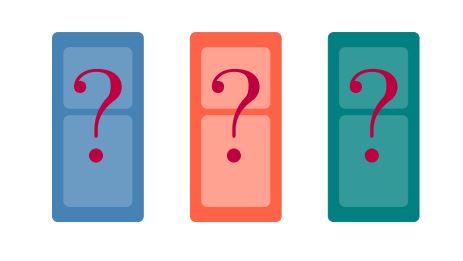
One of the most interesting and intriguing mathematical puzzles is the Monty Hall problem. This problem is a mathematical question based on an old television game show called “Let’s Make a Deal.” It is also well-known in Brazil for being featured in various TV contests. The reason for its fame among mathematical problems is that its solution defies common sense.
Description
The game consists of three closed doors, behind one of which is a prize, while the others conceal goats.
• The participant chooses one door out of the three;
• One of the remaining two doors is opened, revealing a goat;
• The participant has the option to switch their initial choice to the other remaining closed door.
Questions
What is the best strategy for the participant? Should they stick with their initial choice or switch to the other closed door?
The straightforward answer is: switching doors is more advantageous
Solution description
Before we delve into the solution, consider another problem. Again, there are three doors, with only one of them having a prize behind it. You can choose one door or two doors to find the prize. Which choice is the better strategy? Picking one door or two doors? Well, in this case, it’s evident that choosing two doors is a much more advantageous strategy.
We’ll see below that the Monty Hall problem is equivalent to this variant of the game. That is, sticking with the initial door choice in Monty Hall is the same as choosing only one door in the alternative version, while switching doors is equivalent to choosing two doors.
Suppose the probability of the prize being behind any of the three doors is the same, with no dependence relationship between them.
In the alternate version, consider that if the participant chooses only one door, it will be labeled as door A. If they choose two doors, they will be labeled as doors B and C. Thus, choosing one door (A) corresponds to a 1/3 chance of winning the prize, while choosing two doors (B and C) accumulates a 2/3 chance.
Now back to the Monty Hall problem. Let’s label the initial door choice of the participant as door A, and the other doors as B and C. The probability of the prize being behind door A is 1/3, while the probability of it being behind door B or door C is 2/3.
The next step in the game is revealing that one of the remaining doors contains a goat (i.e., it’s not the prize). Switching doors involves the simultaneous consideration that:
• If door B is not the prize, we check if the prize is behind door C;
• If door C is not the prize, we check if the prize is behind door B;
Notice that the above two items exactly correspond to confirming whether the prize is behind door B or door C. This demonstrates that switching doors is equivalent to choosing two doors in the variant of the game, and the presenters initially reveal an unprized door (B or C). Therefore, switching doors guarantees a 2/3 probability of winning the prize, while sticking with the initial choice results in a 1/3 probability.
An essential fact is that the door opened in the second step of the Monty Hall problem will never have the prize behind it. The above equivalence would be immediately invalidated if this possibility existed.
 Na imagem visualizamos o logotipo do projeto 'MatematiZou', escrito com letras de forma na cor verde-azulada. A letra “Z” está na cor branca dentro de um hexágono com pontas arredondadas preenchido na mesma tonalidade de cor do restante das letras.  Na imagem temos um mini caminhão branco de madeira, cuja caçamba é azul escura e está escrito em letras brancas “UFABC”. As rodas do caminhão são vermelhas e quadradas. Cada par de rodas do caminhão está em cima de uma pista com ondulações.  Na imagem, há várias pessoas participando do evento “UFABC para todos” no Ginásio da UFABC campus Santo André. Algumas pessoas estão ao redor de uma mesa com jogos que incluem copos, mapas, tabuleiro de xadrez, entre outros, e outras, estão vendo as exposições espalhadas por todo o ambiente.](https://matematizou.gradmat.ufabc.edu.br/files/LogoMatematizouTeal.png)

